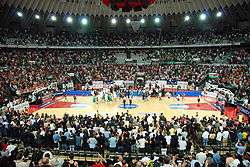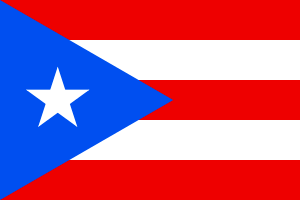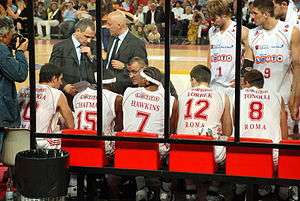Pallacanestro Virtus Roma
| Pallacanestro Virtus Roma | |||
|---|---|---|---|
 | |||
| Leagues | Serie A2 | ||
| Founded | 1960 | ||
| History |
Virtus Aurelia (1960–1972) Pallacanestro Virtus Roma (1972–present) | ||
| Arena | PalaLottomatica | ||
| Capacity | 11,200 | ||
| Location | Rome, Lazio, Italy | ||
| Team colors |
Red, Yellow, Blue | ||
| President | Claudio Toti | ||
| Head coach | Marco Calvani | ||
| Championships |
1 Italian League 1 Italian Supercup 1 FIBA European Champions Cup 2 FIBA Korać Cup 1 FIBA Intercontinental Cup | ||
| Website | virtusroma.it | ||
| Uniforms | |||
|
| |||
Pallacanestro Virtus Roma, known for sponsorship reasons as UniCusano Roma, is an Italian professional basketball club based in Rome, Lazio. It plays in the Italian second division from the 2015-16 season.
It was formerly a major side in Europe, winning the 1983–84 FIBA European Champions Cup and being one of only 13 clubs to hold a Euroleague A license. However its standing later waned and Virtus became less competitive in both Europe and the domestic Serie A - which it had won in 1983 - before voluntaraily relegating to the second division in July 2015.
For past club sponsorship names, see sponsorship names.
History
The club was formed by the merger of two Roman sides, San Saba and Gruppo Borgo Cavalleggeri, under the name Virtus Aurelia in the late 1960s, the founding date of San Saba, 1960, was kept as Virtus'.
In 1972, Virtus Aurelia merged with GS Banco di Roma, the sporting wing of Banco di Roma, forming Pallacanestro Banco di Roma Virtus. The side reached the second division in 1978, staying two years before moving up to the Serie A in 1980.
This was the start of an extended stay in the first division, and success followed soon after, with the side winning the 1983 championship. Earning a place in the 1983–84 FIBA European Champions Cup, Virtus went on to win the competition at its first try, with a Larry Wright led squad, that also had Clarence Kea, Renzo Tombolato and Fulvio Polesello. Wright was decisive in the final against FC Barcelona, scoring 27 points as Roma overturned a halftime 10-point deficit to win the decider.[1] The next season, the Italians added the 1984 FIBA Intercontinental Cup after topping a group of international clubs in Brazil.[2] Roma also won the 1985–86 FIBA Korać Cup against Mobilgirgi Caserta.
The club's next title was the 1991–92 FIBA Korać Cup, by which time Banco di Roma had been replaced as a sponsor by Il Messaggero. A squad comprising Dino Rađa, Rick Mahorn, Roberto Premier and Andrea Niccolai downed Scavolini Pesaro in the two-legged final [1]. The next year Virtus managed to reach the FIBA Korać Cup final again but lost the title by Philips Milano.

During the 2002-03 season, Carlton Myers led the team to a 25-9 record in Serie A as Roma reached the playoff semifinals.[1] After adding Dejan Bodiroga and head coach Svetislav Pešić in the 2005 off-season, Virtus reached the ULEB Cup quarterfinals, the Serie A semifinals and the Italian Cup final, that it lost in overtime.[1]
In the summer of 2011, the Italian club's Euroleague A-license was suspended after it finished in the bottom half of the Serie A.[3] The next year it lost the license completely after having the worst record among A license clubs, it was replaced by EA7 Emporio Armani Milano.[4]
In a strange twist, Virtus Roma then went on to have an excellent season, unexpectedly, by their own admission, reaching the Serie A finals, which would earn it the right to return to the Euroleague. However the club relinquished their rights as they did not answer some of the competition's requirements (in particular minimum arena capacity), earning a place in the second tier Eurocup instead.[5]
In July 2015, despite having satisfied the economic conditions to participate in Serie A, the management asked to participate in the second division Serie A2 instead, the permission was granted by the Federation. The cited motives for the move was an insufficient budget to be competitive at the higher level and the desire to structure the club on a youth policy.[6][7][8]
Arena
Virtus plays at the Palazzetto dello Sport (capacity:3,500) since the 2011-12 season. It had previously played there until 1983, moving into the PalaLottomatica (capacity:11,200), where it stayed until 2011, except between 2000 and 2003 for renovation work.[9] Since downscaling operations due to reduced funds, Virtus has found the operating costs of the PalaLottomatica prohibitive and has avoided playing in the larger arena, even during the 2013 finals.[10]
In June 9, 2018, Virtus Roma reached a new deal with All Events SpA, PalaLottomatica operator, to play 2018-19 Serie A2 season there.[11]
Roster
Note: Flags indicate national team eligibility at FIBA sanctioned events. Players may hold other non-FIBA nationality not displayed.
| Pallacanestro Virtus Roma roster | |||||||||||||||||||||||||||||||||
|---|---|---|---|---|---|---|---|---|---|---|---|---|---|---|---|---|---|---|---|---|---|---|---|---|---|---|---|---|---|---|---|---|---|
| Players | Coaches | ||||||||||||||||||||||||||||||||
|
Updated: August 18, 2016 | ||||||||||||||||||||||||||||||||
Honours

Total titles: 6
Domestic competitions
- Runners-up (2): 1989–90, 2005–06
- Winners (1): 2000
European competitions
- Winners (1): 1983–84
- FIBA Korać Cup (defunct)
- European Basketball Club Super Cup (semi-official, defunct)
- Runners-up (1): 1983
Worldwide competitions
- Winners (1): 1984
The road to the European victories
|
1983–84 FIBA European Champions Cup
|
1985–86 FIBA Korać Cup
|
1991–92 FIBA Korać Cup
| ||||||||||||||||||||||||||||||||||||||||||||||||||||||||||||||||||||||||||||||||||||||||||||
Season by season record
The following table shows the records from the season 1977–78 in all competitions:
| Season | Tier | League | Pos. | Postseason | Italian Cup | Supercup | Europe | Worldwide | ||
|---|---|---|---|---|---|---|---|---|---|---|
| 1977–78 | 3 | Serie B | 4 | – | – | – | – | – | – | |
| 1978–79 | 2 | Serie A2 | 5 | – | – | – | – | – | – | – |
| 1979–80 | 2 | Serie A2 | 3 | – | – | – | – | – | – | |
| 1980–81 | 1 | Serie A | 10 | – | – | – | – | – | – | – |
| 1981–82 | 1 | Serie A | 10 | – | – | – | – | – | – | – |
| 1982–83 | 1 | Serie A | 1 | Champions | – | – | Korać Cup | Top 16 | – | – |
| 1983–84 | 1 | Serie A | 9 | – | Quarterfinalist | – | Euroleague | Champions | – | – |
| 1984–85 | 1 | Serie A | 1 | Quarterfinalist | Quarterfinalist | – | Euroleague | Top 6 | Intercontinental Cup | Champions |
| 1985–86 | 1 | Serie A | 10 | Quarterfinalist | Quarterfinalist | – | Korać Cup | Champions | Intercontinental Cup | 8 |
| 1986–87 | 1 | Serie A | 8 | Top 12 | Top 32 | – | – | – | – | – |
| 1987–88 | 1 | Serie A | 10 | Quarterfinalist | Quarterfinalist | – | – | – | – | – |
| 1988–89 | 1 | Serie A | 12 | – | Top 32 | – | – | – | – | – |
| 1989–90 | 1 | Serie A | 8 | Quarterfinalist | Finalist | – | – | – | – | – |
| 1990–91 | 1 | Serie A | 4 | Semifinalist | Top 16 | – | – | – | – | – |
| 1991–92 | 1 | Serie A | 6 | Semifinalist | Quarterfinalist | – | Korać Cup | Champions | – | – |
| 1992–93 | 1 | Serie A | 12 | – | Top 16 | – | Korać Cup | Finalist | – | – |
| 1993–94 | 1 | Serie A | 15 | – | Top 32 | – | – | – | – | – |
| 1994–95 | 1 | Serie A | 8 | Quarterfinalist | Quarterfinalist | – | – | – | – | – |
| 1995–96 | 1 | Serie A | 6 | Quarterfinalist | Quarterfinalist | – | – | – | – | – |
| 1996–97 | 1 | Serie A | 6 | Quarterfinalist | Quarterfinalist | – | Korać Cup | Quarterfinalist | – | – |
| 1997–98 | 1 | Serie A | 8 | Quarterfinalist | Quarterfinalist | – | Korać Cup | Semifinalist | – | – |
| 1998–99 | 1 | Serie A | 6 | Quarterfinalist | Quarterfinalist | – | Korać Cup | Top 16 | – | – |
| 1999–00 | 1 | Serie A | 6 | Top 14 | Quarterfinalist | – | Korać Cup | Quarterfinalist | – | – |
| 2000–01 | 1 | Serie A | 5 | Quarterfinalist | Semifinalist | Champions | – | – | – | – |
| 2001–02 | 1 | Serie A | 8 | Quarterfinalist | – | – | – | – | – | – |
| 2002–03 | 1 | Serie A | 2 | Semifinalist | Quarterfinalist | – | – | – | – | – |
| 2003–04 | 1 | Serie A | 7 | Quarterfinalist | Quarterfinalist | – | Euroleague | Regular season | – | – |
| 2004–05 | 1 | Serie A | 6 | Semifinalist | Semifinalist | – | – | – | – | – |
| 2005–06 | 1 | Serie A | 6 | Semifinalist | Quarterfinalist | – | Eurocup | Quarterfinalist | – | – |
| 2006–07 | 1 | Serie A | 4 | Semifinalist | Quarterfinalist | – | Euroleague | Top 16 | – | – |
| 2007–08 | 1 | Serie A | 2 | Finalist | Quarterfinalist | – | Euroleague | Top 16 | – | – |
| 2008–09 | 1 | Serie A | 2 | Quarterfinalist | Quarterfinalist | – | Euroleague | Top 16 | – | – |
| 2009–10 | 1 | Serie A | 7 | Semifinalist | – | – | Euroleague | Regular season | – | – |
| 2010–11 | 1 | Serie A | 9 | – | – | – | Euroleague | Top 16 | – | – |
| 2011–12 | 1 | Serie A | 13 | – | – | – | – | – | – | – |
| 2012–13 | 1 | Serie A | 3 | Finalist | Semifinalist | – | – | – | – | – |
| 2013–14 | 1 | Serie A | 6 | Semifinalist | Quarterfinalist | – | Eurocup | Regular season | – | – |
| 2014–15 | 1 | Serie A | 10 | – | – | Eurocup | Top 16 | – | – | |
| 2015–16 | 2 | Serie A2 | – | – | – | – | – | – | – | – |
Notable players
2010s



.svg.png)





2000s


















.svg.png)
















1990s

























1980s


















1970s


Coaches

|
|
Sponsorship names
Throughout the years, due to sponsorship, the club has been known as:
- Virtus Aurelia (no sponsorship, 1960–61 until 1971–72)
- Banco di Roma Virtus (1972–73 until 1987–88)
- Phonola Roma (1988–89)
- Il Messaggero Roma (1989–90 until 1991–92)
- Virtus Roma (no sponsorship, 1992–93)
- Burghy Roma (1993–94)
- Teorematour Roma (1994–95)
- Nuova Tirrena Roma (1995–96)
- Telemarket Roma (1996–97)
- Calze Pompea Roma (1997–98 until 1998–99)
- Aeroporti di Roma Virtus (1999–00 until 2000–01)
- Würth Roma (2001–02)
- Lottomatica Roma (2002–03 until 2010–11)
- Acea Roma (2011–12 until 2015–16)
- UniCusano Roma (2016–17 to present)
References
- 1 2 3 4 "Club profile: Virtus Rome". Eurocup Basketball. 13 September 2013. Retrieved 17 July 2015.
- ↑ Stankovic, Vladimir (2 December 2013). "Larry Wright, the man with two rings". Euroleague. Retrieved 17 July 2015.
- ↑ "New teams proposed as 2011-12 Turkish Airlines Euroleague participants". Euroleague. 30 June 2011. Retrieved 17 July 2015.
- ↑ "Euroleague board awards two-year Turkish Airlines Euroleague license to EA7 Emporio Armani Milan". Euroleague. 20 June 2012. Retrieved 17 July 2015.
- ↑ "Rome announces it will not play in Turkish Airlines Euroleague". Euroleague. 21 June 2013. Retrieved 17 July 2015.
- ↑ Canfora, Mario (16 July 2015). "Basket, Serie A: Roma si retrocede in A-2. Caserta ripescata" [Basketball, Serie A: Roma relegates itself to A-2. Caserta retaken]. La Gazzetta dello Sport (in Italian). Rome. Retrieved 17 July 2015.
- ↑ "Consiglio federale a Roma. Barilla sponsor della maglia Azzurra, Ammissioni ai Campionati 2015-16, Prandi presidente CIA" [Federal council in Rome. Barilla sponsor of the blue shirt, 2015-16 championship admissions, Prandi CIA president]. Federazione Italiana Pallacanestro (in Italian). 17 July 2015. Retrieved 17 July 2015.
- ↑ "Basket: l'Acea Virtus riparte dai giovani e dal territorio" [Basketball: Acea Virtus starts again from youth and territory]. Pallacanestro Virtus Roma (in Italian). 16 July 2015. Retrieved 17 July 2015.
- ↑ "Il Palazzetto dello Sport" [The Palazzetto dello Sport]. Pallacanestro Virtus Roma (in Italian). Retrieved 18 July 2015.
- ↑ Corio, Paolo (14 June 2013). "Finali basket: perché Roma non vuole il PalaEUR" [Basketball finals: why doesn't Rome want the PalaEUR]. Panorama (magazine) (in Italian). Retrieved 18 July 2015.
- ↑ "Virtus Roma: accordo raggiunto, si torna al PalaLottomatica" [Virtus Roma: new agreement reached and will play at PalaLottomatica]. sportando.basketball (in Italian). 9 June 2018.
External links
| Wikimedia Commons has media related to Pallacanestro Virtus Roma. |
- Serie A historical results (in Italian) Retrieved 18 July 2015
- Eurobasket.com profile